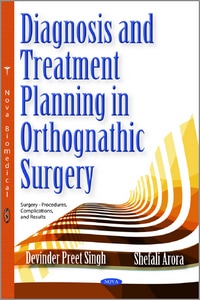Authors:
- DEVINDER PREET SINGH
- SHEFALI ARORA
Description:
“The human face should be in perfect harmony and balance along with ideal functioning of the stomatognathic system…” was a view idealized by Apollo Belvedere, who created the neoclassical Greek sculpture of the head and face. However, Nature ensures that all of us are not blessed with perfect faces. It is for the resolution of these imperfections that orthodontic treatment is sought. But for patients whose problems are so severe that neither growth nor camouflage offers an ideal solution, surgical realignment of jaws or repositioning of dentoalveolar segments is the only choice. Surgery is not a substitute for orthodontics in these patients; instead, it must be properly coordinated with orthodontics and other dental treatment to achieve overall positive results.
With recent advances in surgical technology, it is now possible to treat these patients successfully for whom orthodontic camouflage would have resulted in esthetically unacceptable and often unstable results. This art and science of diagnosis, treatment planning, and execution of treatment of dentofacial deformities by combining orthodontics, oral and maxillofacial surgery to correct severe musculoskeletal, dento-osseous, and soft tissue deformities of the jaws and associated structures is called orthognathic surgery. Successful orthognathic surgery demands the understanding and cooperation of the oral and maxillofacial surgeon, orthodontist, and general dentist. Each must provide a proper diagnosis and treatment plan, perform necessary treatment and refer to necessary treatment outside his or her respective area of expertise. In order for patients to receive state-of-art care when correcting their deformities, the orthognathic team must: 1. recognize the various characteristics of malocclusion and dento-facial deformity; 2. define the nature of the problem, including the possible etiology; and 3. design a treatment strategy based on the specific needs and desires of the individual. In this modern era, the role of the doctor has shifted from that of sole decision maker in the planning process to that of a partner with the patient as co-decision-maker. Therefore, the clinician must not overlook the importance of including the patient and parents in the treatment planning process. Ackermann and Proffit have suggested that clinicians are generally more influenced by objective findings (problem list) and patients are more influenced by subjective findings (their perception of their needs and values). This dichotomy makes communication an effective tool when one is faced with the decision between orthodontic camouflage and surgical orthodontic correction. The authors’ of this book examine the diagnosis and treatment planning in orthognathic surgery.
ISBN: 978-1-63485-039-1
Published Date: 2016
Page Count: 155 , File Size: 6 Mb
PDF Download link |
|
|
Links are available to Premium users onlyJOIN US HERE |
